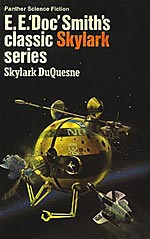
![]() couchtomoon
couchtomoon
8/9/2016
![]()
I'd like to preface this by pointing out that this book was first serialized in 1965. I know that doesn't mean much to a lot of SF readers who assume that everything old is "bad" and everything new is either fresh, progressive, or in some way worth reading, and who balk at the minor suggestion to dip into the vintage pond occasionally, if only to gain a new perspective on the modern things they've been reading and perhaps expand on the historical timeline we have in our heads, but reading old SF will at least confirm that yes, a lot of old SF is not very good, though for a variety of reasons and to varying degrees, but it will also likely demonstrate that it isn't much different from a lot of the stuff being churned out and popularized today.
The thing is, this story feels like it should have been published in the 1930s. Although the '60s gave us plenty of stilt and cringe, it's a different kind of stilt and cringe, and Skylark Duquesne just isn't that, er, hip. As Doc Smith's final installment in his decades-long Skylark series, the story style doesn't mature along with its fans (assuming they matured) and the rest of SF, but I guess fans were fine with it because it was nominated for a Hugo award (never a sign of quality in any year, as you know from my constant bitching, but this one feels more like a retro Hugo contender, i.e. an old fan favorite based on unreliable, fuzzy memories and childhood sentimentality).
The story's big hook is that longtime enemies, Dick Seaton and Marc Duquesne (whose name is not Skylark, apparently), must collaborate to defeat the evil Chlorans who are hellbent on conquering and enslaving the entire universe. Seaton enlists the help of friends (and his doting wife, Dottie), while Duquesne pulls on the strings (and sexual attentions) of alien humanoids formerly enslaved by the Chlorans. Universe-crossing psi-power helmets and galaxy-hopping transport are the norm, as is a galaxy-spanning triggering of supernova suns to rid humanity of this pesky Chloran threat.
It's also important to note that the women of this novel all know exactly when to be sexy, smart, kick-ass, and conveniently subservient to the men. It's a delicate art! Although there are some tongue-in-cheek moments of commentary on this sexism, it's not convincing, even by 1960 standards. Additionally, Smith enlisted the help of a female neighbor to help the "feminine" aspects of book writing--whatever those are--giving her credit on the first novel, only to excise her contributions in later editions of the following novels. Boo.
Oh, also, there's racism, in the form of stereotyped inclusiveness and white default superiority. It's cringe city.
I've been half joking and half serious when I suggest sampling SF series in the middle, rather than the beginning, because you can skip all the unnecessary and contrived exposition SF is too often known for (yes, even today) and get to the heart of the action. It works, so far, but for the Skylark series, I skipped to the final book. This tactic did require a little bit of online background reading just orient myself because, unlike my experiences with Burroughs, Hamilton, and other Doc books, Skylark lacks those nifty little editor-recommended asides that catch up new readers to the ongoing story. Instead, the story skips over major explanations, like the source of the rift between Seaton and his temporary frenemy, Duquesne, what those helmets are all about, and what the hell a Skylark even is.
Not that it matters! Skylark Duquesne is nothing more than engineering heroics about inventors who gain power by making things harder, better, faster, stronger and save Earth's humanity from crazy aliens by completely annihilating those crazy aliens. It fits perfectly within Clute and Nicholl's label, "Edisonade," and you know the how the saying goes: "When life gives you Edisons... you commit genocide."
http://couchtomoon.wordpress.com